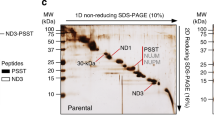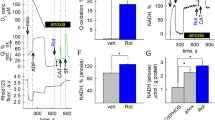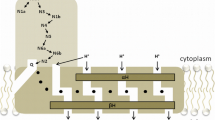Abstract
Elevation of intracellular Zn2+ following ischemia contributes to cell death by affecting mitochondrial function. Zn2+ is a differential regulator of the mitochondrial enzyme lipoamide dehydrogenase (LADH) at physiological concentrations (Ka = 0.1 µM free zinc), inhibiting lipoamide and accelerating NADH dehydrogenase activities. These differential effects have been attributed to coordination of Zn2+ by LADH active-site cysteines. A detailed kinetic mechanism has now been developed for the diaphorase (NADH-dehydrogenase) reaction catalyzed by pig heart LADH using 2,6-dichlorophenol-indophenol (DCPIP) as a model quinone electron acceptor. Anaerobic stopped-flow experiments show that two-electron reduced LADH is 15-25-fold less active towards DCPIP reduction than four-electron reduced enzyme, or Zn2+-modified reduced LADH (the corresponding values of the rate constants are (6.5 ± 1.5) × 103 M–1·s–1, (9 ± 2) × 104 M–1·s–1, and (1.6 ± 0.5) × 105 M–1·s–1, respectively). Steady-state kinetic studies with different diaphorase substrates show that Zn2+ accelerates reaction rates exclusively for two-electron acceptors (duroquinone, DCPIP), but not for one-electron acceptors (benzoquinone, ubiquinone, ferricyanide). This implies that the two-electron reduced form of LADH, prevalent at low NADH levels, is a poor two-electron donor compared to the four-electron reduced or Zn2+-modified reduced LADH forms. These data suggest that zinc binding to the active-site thiols switches the enzyme from one- to two-electron donor mode. This zinc-activated switch has the potential to alter the ratio of superoxide and H2O2 generated by the LADH oxidase activity.







Similar content being viewed by others
Abbreviations
- DCPIP:
-
2,6-dichlorophenol-indophenol
- LADH:
-
dihydrolipoyl dehydrogenase (=lipoamide dehydrogenase)
- KGDHC:
-
α-ketoglutarate dehydrogenase complex
REFERENCES
Koh, J.-Y., Suh, S. W., Gwag, B. J., He, Y. Y., Hsu, C. Y., and Choi, D. W. (1996) The role of zinc in selective neuronal death after transient global cerebral ischemia, Science, 272, 1013-1016, doi: https://doi.org/10.1126/science.272.5264.1013.
Choi, D. W., and Koh, J. Y. (1998) Zinc and brain injury, Ann. Rev. Neurosci., 21, 347-375, doi: https://doi.org/10.1146/annurev.neuro.21.1.347.
Sensi, S. L., Paoletti, P., Bush, A. I., and Sekler, I. (2009) Zinc in the physiology and pathology of the CNS, Nat. Rev. Neurosci., 10, 780-791, doi: https://doi.org/10.1038/nrn2734.
Shuttleworth, C. W., and Weiss, J. H. (2011) Zinc: new clues to diverse roles in brain ischemia, Trends Pharmacol. Sci., 32, 480-486, doi: https://doi.org/10.1016/j.tips.2011.04.001.
Skulachev, V. P., Christyakov, V. V., Jasaitis, A. A., and Smirnova, E. G. (1967) Inhibition of the respiratory chain by zinc ions, Biochem. Biophys. Res. Commun., 26, 1-6, doi: https://doi.org/10.1016/0006-291x(67)90242-2.
Sensi, S. L., Yin, H. Z., Carriedo, S. G., Rao, S. S., and Weiss, J. H. (1999) Preferential Zn2+ influx through Ca2+-permeable AMPA/kainate channels triggers prolonged mitochondrial superoxide production, Proc. Natl. Acad. Sci. USA, 96, 2414-2419, doi: https://doi.org/10.1073/pnas.96.5.2414.
Dong, W., Qi, Z., Liang, J., Shi, W., Zhao, Y., Luo, Y., Ji, X., and Liu, K. J. (2015) Reduction of zinc accumulation in mitochondria contributes to decreased cerebral ischemic injury by normobaric hyperoxia treatment in an experimental stroke model, Exp. Neurol., 272, 181-189, doi: https://doi.org/10.1016/j.expneurol.2015.04.005.
Gazaryan, I. G., Krasinskaya, I. P., Kristal, B. S., and Brown, A. M. (2007) Zinc irreversibly damages major enzymes of energy production and antioxidant defense prior to mitochondrial permeability transition, J Biol. Chem., 282, 24373-24380, doi: https://doi.org/10.1074/jbc.M611376200.
Ji, S. G., Medvedeva, Yu. V., and Weiss, J. H. (2020) Zn2+ entry through the mitochondrial calcium uniporter is a critical contributor to mitochondrial dysfunction and neurodegeneration, Exp. Neurol., 325, 113161, doi: https://doi.org/10.1016/j.expneurol.2019.113161.
Brown, A. M., Kristal, B. S., Effron, M. S., Shestopalov, A. I., Ullucci, P. A., Sheu, K.-F. R., Blass, J. P., and Cooper, A. J. L. (2000) Zn2+ inhibits alpha-ketoglutarate-stimulated mitochondrial respiration and the isolated alpha-ketoglutarate dehydrogenase complex, J. Biol. Chem., 275, 13441-13447, doi: https://doi.org/10.1074/jbc.275.18.13441.
Casola, L., Brumby, P. E., and Massey, V. (1966) The reversible conversion of lipoyl dehydrogenase to an artifactual enzyme by oxidation of sulfhydryl groups, J. Biol. Chem., 241, 4977-4984.
Veeger, C., and Massey, V. (1962) Inhibition of lipoyl dehydrogenase by trace metals, Biochim. Biophys. Acta, 64, 83-100, doi: https://doi.org/10.1016/0006-3002(60)90108-6.
Casola, L., and Massey, V. (1966) Differential effects of mercurial on the lipoyl reducatase and diaphorase activities of lipoyl dehydrogenase, J. Biol. Chem., 241, 4985-4993.
Nakamura, M., and Yamazaki, I. (1972) One-electron transfer reactions in biochemical systems. VI. Changes in electron transfer mechanism of lipoamide dehydrogenase by modification of sulfhydryl groups, Biochim. Biophys. Acta, 267, 249-257, doi: https://doi.org/10.1016/0005-2728(72)90113-2.
Thorpe, C., and Williams, C. H., Jr. (1975) Modification of pig heart lipoamide dehydrogenase by cupric ions, Biochemistry, 14, 2419-2424, doi: https://doi.org/10.1021/bi00682a023.
Lowe, C. R. (1977) Immobilised lipoamide dehydrogenase. 2. Properties of the enzyme immobilised to agarose through spacer molecules of various lengths, Eur. J. Biochem., 76, 401-409, doi: https://doi.org/10.1111/j.1432-1033.1977.tb11608.x.
Gutierrez Correa, J., and Stoppani, A. O. M. (1993) Inactivation of lipoamide dehydrogenase by cobalt(II) and iron(II) Fenton systems: effect of metal chelators, thiol compounds and adenine nucleotides, Free Radic. Res. Commun., 19, 303-314, doi: https://doi.org/10.3109/10715769309056519.
Olsson, J. M., Xia, L., Eriksson, L. C., and Bjornstedt, M. (1999) Ubiquinone is reduced by lipoamide dehydrogenase and this reaction is potently stimulated by zinc, FEBS Lett., 448, 190-192, doi: https://doi.org/10.1016/s0014-5793(99)00363-4.
Xia, L., Bjornstedt, M., Nordman, T., Eriksson, L. C., and Olsson, J. M. (2001) Reduction of ubiquinone by lipoamide dehydrogenase. An antioxidant regenerating pathway, Eur. J. Biochem., 268, 1486-1490, doi: https://doi.org/10.1046/j.1432-1327.2001.02013.x.
Hopkins, N., and Williams, C. H., Jr. (1995) Characterization of lipoamide dehydrogenase from Escherichia coli lacking the redox active disulfide: C44S and C49S, Biochemistry, 34, 11757-11765, doi: https://doi.org/10.1021/bi00037a013.
Gazaryan, I. G., Krasnikov, B. F., Ashby, G. A., Thorneley, R. N., Kristal, B. S., and Brown, A. M. (2002) Zinc is a potent inhibitor of thiol oxidoreductase activity and stimulates reactive oxygen species production by lipoamide dehydrogenase, J. Biol. Chem., 277, 10064-10072, doi: https://doi.org/10.1074/jbc.M108264200.
Popov, V. O., Gazarian, I. G., Egorov, A. M., and Berezin, I. V. (1985) NAD-dependent hydrogenase from the hydrogen-oxidizing bacterium Alcaligenes eutrophus Z-1. Kinetic studies of the NADH-dehydrogenase activity, Biochim. Biophys. Acta, 827, 466-471.
Maeda-Yorita, K., Russell, G. C., Guest, J. R., Massey, V., and Williams, C. H., Jr. (1991) Properties of lipoamide dehydrogenase altered by site-directed mutagenesis at a key residue (I184Y) in the pyridine nucleotide binding domain, Biochemistry, 30, 11788-11795, doi: https://doi.org/10.1021/bi00115a008.
Van Berkel, W. J. H., Regelink, A. G., Beintema, J. J., and de Kok, A. (1991) The conformational stability of the redox states of lipoamide dehydrogenase from Azotobacter vinelandii, Eur. J. Biochem., 202, 1049-1055, doi: https://doi.org/10.1111/j.1432-1033.1991.tb16469.x.
Tsai, C. S. (1980) Kinetic studies of multifunctional reactions catalysed by lipoamide dehydrogenase, Int. J. Biochem., 11, 407-413, doi: https://doi.org/10.1016/0020-711x(80)90311-0.
Vienozinskis, J., Butkus, A., Cenas, N., and Kulys, J. (1990) The mechanism of the quinone reductase reaction of pig heart lipoamide dehydrogenase, Biochem. J., 269, 101-105, doi: https://doi.org/10.1042/bj2690101.
Williams, C. H., Arscott, L. D., Muller, S., Lennon, B. W., Ludwig, M. L., Wang, P. F., Veine, D. M., Becker, K., and Schirmer, R. H. (2000) Thioredoxin reductase two modes of catalysis have evolved, Eur. J. Biochem., 267, 6110-6117, doi: https://doi.org/10.1046/j.1432-1327.2000.01702.x.
Lennon, B. W., and Williams, C. H., Jr. (1996) Enzyme-monitored turnover of Escherichia coli thioredoxin reductase: insights for catalysis, Biochemistry, 35, 4704-4712, doi: https://doi.org/10.1021/bi952521i.
Lennon, B. W., Williams, C. H., Jr., and Ludwig, M. L. (2000) Twists in catalysis: alternating conformations of Escherichia coli thioredoxin reductase, Science, 289, 1190-1194, doi: https://doi.org/10.1126/science.289.5482.1190.
Williams, C. H., Jr. (1995) Mechanism and structure of thioredoxin reductase from Escherichia coli, FASEB J., 9, 1267-1276, doi: https://doi.org/10.1096/fasebj.9.13.7557016.
Dooijewaard, G., and Slater, E. C. (1976) Steady-state kinetics of high molecular weight (type-I) NADH dehydrogenase, Biochim. Biophys. Acta, 440, 1-15, doi: https://doi.org/10.1016/0005-2728(76)90109-2.
Bando, Y., and Aki, K. (1991) Mechanisms of generation of oxygen radicals and reductive mobilization of ferritin iron by lipoamide dehydrogenase, J. Biochem., 109, 450-454, doi: https://doi.org/10.1093/oxfordjournals.jbchem.a123402.
Gaballa, A., and Helmann, J. D. (2002) A Peroxide-induced zinc uptake system plays an important role in protection against oxidative stress in Bacillus subtilis, Mol. Microbiol., 45, 997-1005, doi: https://doi.org/10.1046/j.1365-2958.2002.03068.x.
Nordman, T., Xia, L., Björkhem-Bergman, L., Damdimopoulos, A., Nalvarte, I., Arnér, E. S., Spyrou, G., Eriksson, L. C., Björnstedt, M., and Olsson, J. M. (2003) Regeneration of the antioxidant ubiquinol by lipoamide dehydrogenase, thioredoxin reductase and glutathione reductase, Biofactors, 18, 45-50, doi: https://doi.org/10.1002/biof.5520180206.
Galasso, S. L., and Dyck, R. H. (2007) The role of zinc in cerebral ischemia, Mol. Med., 13, 380-387, doi: https://doi.org/10.2119/2007-00044.Galasso.
Levenson, C. W. (2005) Zinc supplementation: neuroprotective or neurotoxic? Nutr. Rev., 63, 122-125, doi: https://doi.org/10.1111/j.1753-4887.2005.tb00130.x.
Ischia, J., Bolton, D. M., and Patel, O. (2019) Why is it worth testing the ability of zinc to protect against ischaemia reperfusion injury for human application, Metallomics, 11, 1330-1343, doi: https://doi.org/10.1039/c9mt00079h.
Aquilani, R., Baiardi, P., Scocchi, M., Iadarola, P., Verri, M., Sessarego, P., Boschi, F., Pasini, E., Pastoris, O., and Viglio, S. (2009) Normalization of zinc intake enhances neurological retrieval of patients suffering from ischemic strokes, Nutr. Neurosci., 12, 219-225, doi: https://doi.org/10.1179/147683009X423445.
Kitamura, Y., Iida, Y., Abe, J., Ueda, M., Mifune, M., Kasuya, F., Ohta, M., Igarashi, K., Saito, Y., and Saji, H. (2006) Protective effect of zinc against ischemic neuronal injury in a middle cerebral artery occlusion model, J. Pharmacol. Sci., 100, 142-148, doi: https://doi.org/10.1254/jphs.fp0050805.
Osipyants, A. I., Smirnova, N. A., Khristichenko, A. Yu., Nikulin, S. V., Zakhariants, A. A., Tishkov, V. I., Gazaryan, I. G., and Poloznikov, A. A. (2018) Metal ions as activators of hypoxia inducible factor, Moscow University Chem. Bull., 73, 13-18.
Maret, W. (2015) Analyzing free zinc(II) ion concentrations in cell biology with fluorescent chelating molecules, Metallomics, 7, 202-211, doi: https://doi.org/10.1039/c4mt00230j.
McCranor, B. J., Bozym, R. A., Vitolo, M. I., Fierke, C. A., Bambrick, L., Polster, B. M., Fiskum, G., and Thompson, R. B. (2012) Quantitative imaging of mitochondrial and cytosolic free zinc levels in an in vitro model of ischemia/reperfusion, J. Bioenerg. Biomembr., 44, 253-263, doi: https://doi.org/10.1007/s10863-012-9427-2.
Acknowledgements
The authors thank Mrs. Gill A. Ashby and Prof. Roger N. F. Thorneley (UK) for their invaluable help with transient kinetics experiments.
Funding
The work in part was supported by the Russian Foundation for Basic Research (projects Nos. 20-04-00921, 17-54-33027, and 18-29-09154).
Author information
Authors and Affiliations
Corresponding author
Ethics declarations
The authors declare no conflict of interest in financial or any other sphere. This article does not contain any studies with human participants or animals performed by any of the authors.
Rights and permissions
About this article
Cite this article
Gazaryan, I.G., Shchedrina, V.A., Klyachko, N.L. et al. Zinc Switch in Pig Heart Lipoamide Dehydrogenase: Steady-State and Transient Kinetic Studies of the Diaphorase Reaction. Biochemistry Moscow 85, 908–919 (2020). https://doi.org/10.1134/S0006297920080064
Received:
Revised:
Accepted:
Published:
Issue Date:
DOI: https://doi.org/10.1134/S0006297920080064




